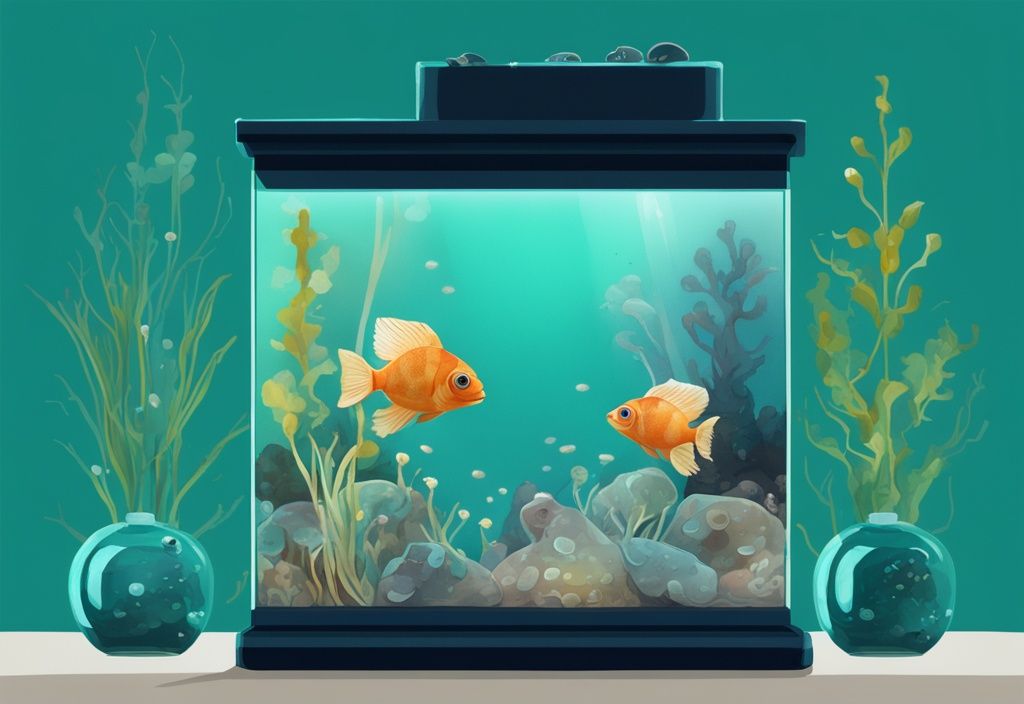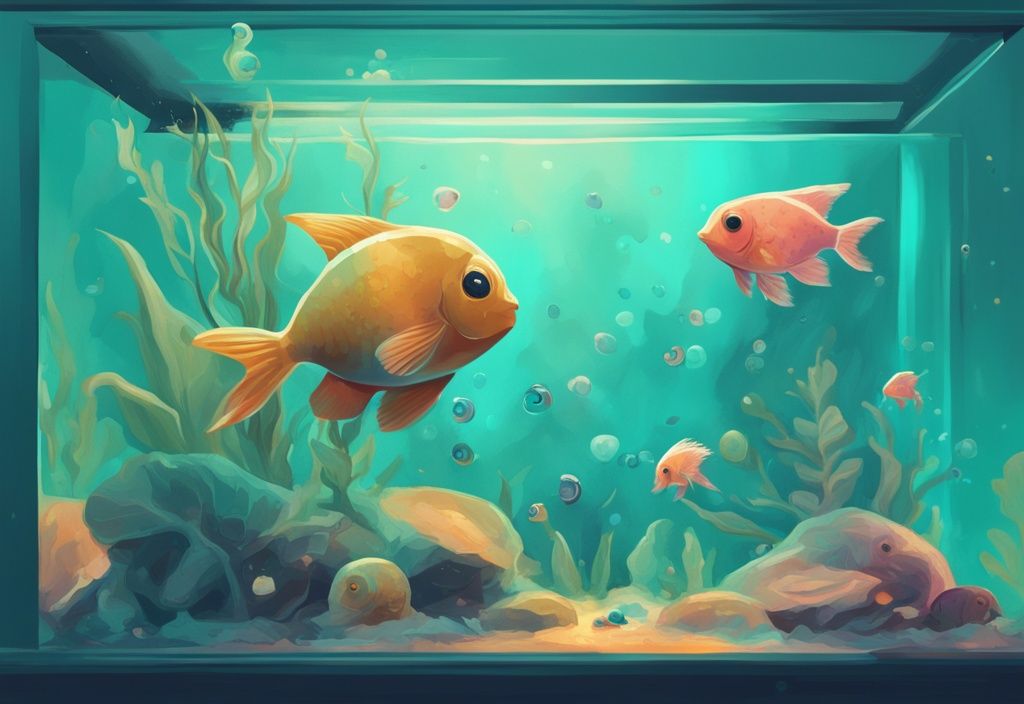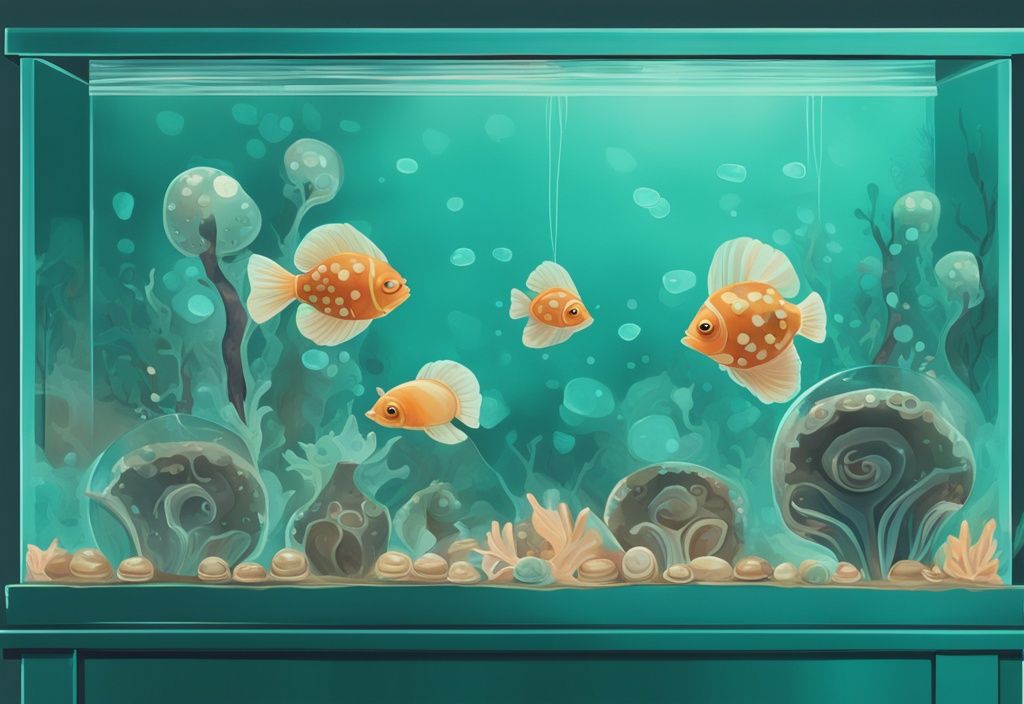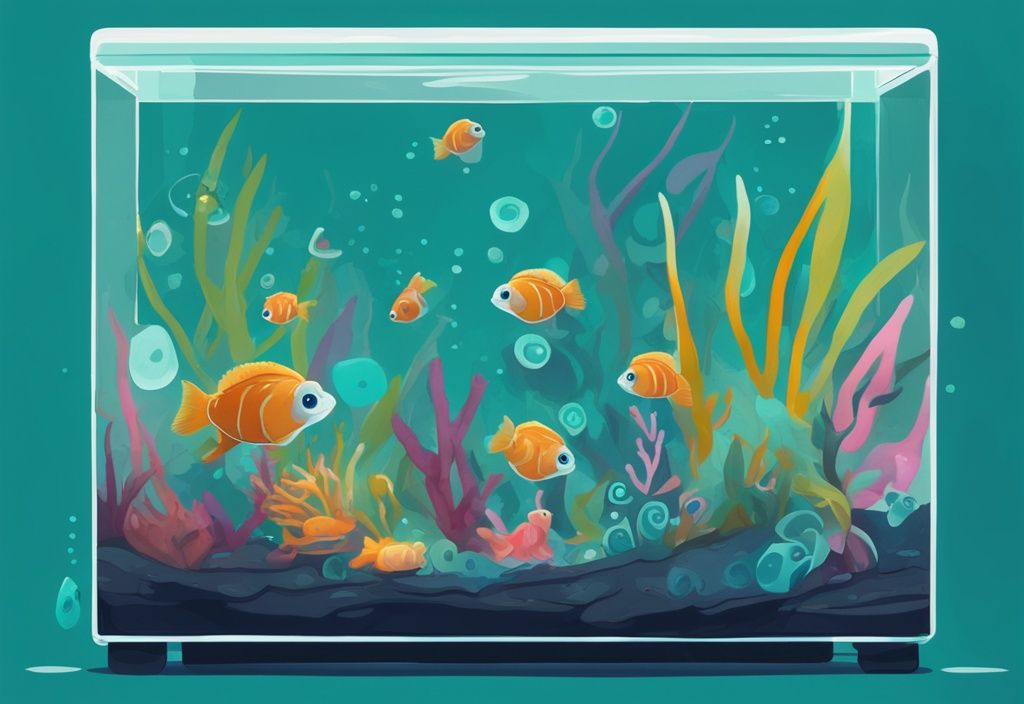Has your serene aquarium oasis suddenly become a nursery for baby snails? You’re far from alone in this slippery situation. As a seasoned marine biologist, I’ve found that these tiny intruders often sneak in via live plants or ornaments and multiply uninvitedly, perplexing even the experienced aquarists amongst us.
Our quest today is to understand why these baby snails choose your fish tank as their playground and what that means for your aquatic neighbours. Does this sudden invasion signify a crisis or could it instead signal a thriving ecosystem?
Through this lens of curiosity, we’ll be addressing the causes, solutions, and impacts of baby snails inside your tanks. My hope is to equip you with practical, science-smart strategies to restore your aquarium’s balance, enhancing both snail management and your overall aquarist expertise.
Why Did Baby Snails Appear in Your Fish Tank?
Encountering baby snails in your fish tank can be a common and perplexing experience for aquarists. These tiny invaders often appear unexpectedly, creating challenges in maintaining the delicate balance of aquatic environments. Recognizing the potential entry points for these snails can help manage and prevent future outbreaks.
Possible Entry Paths for Snails
Baby snails typically find their way into your fish tank through various unsuspected means. Once introduced, they can rapidly multiply, leading to a noticeable increase in their population. Understanding these entry paths is crucial for controlling their spread and maintaining a harmonious aquatic environment.
Introduction via Live Plants
One common entry route for baby snails is through live plants purchased from pet stores. These plants can harbor snail eggs or small snails that are often overlooked during purchase. Snails frequently bury themselves among the plant roots or cling to the underside of leaves, making them difficult to detect at first glance.
Hitchhiking on Decorations
Another common way baby snails enter your tank is by hitchhiking on decorations or substrate from other tanks. When transferring decorations or using substrate from different aquariums, hidden snail eggs or juvenile snails can be introduced into the new environment. Even items that seem pre-cleaned can harbor these tiny invaders, given their small size and knack for going unnoticed.
Identifying the Types of Snails in Your Fish Tank
- Recognizing the type of snails present can guide you in taking the necessary steps for effective management and control.
Commonly Found Snails in Home Aquariums
- Home aquaria often harbor various snail species, each with its unique traits.
Bladder Snails
Bladder snails are tiny yet conspicuous, easily recognized by their small, brownish shells dotted with darker spots. These snails can grow up to 1.5 cm in length and have a lifespan of up to two years. They multiply rapidly, which can surprise aquarists, especially when baby snails appeared in my fish tank. Bladder snails are highly efficient at consuming waste products and dead or rotting fish eggs. They play a crucial role in maintaining a clean tank, despite their tendency for overpopulation.
Pond Snails
Pond snails stand out due to their thicker tentacles and distinct right-turned shells. Under favorable conditions, their reproduction rate spikes, leading to an influx of baby snails. These snails are incredibly hardy and can appear even in meticulously maintained tanks. Knowing their behavior helps implement effective control measures, particularly when baby snails have appeared in your fish tank unexpectedly.
Ramshorn Snails
Ramshorn snails are characterized by their flat, coiled shells that come in a plethora of colors.
They are beneficial as they consume algae and debris, aiding in the tank’s cleanliness. However, their swift reproductive capabilities mean that even a few baby snails appearing in my fish tank can quickly escalate to an overpopulation problem. Regular scrutiny and management are crucial to avert potential infestations.
The Ecology of Snails: Pros and Cons
- Snails play a crucial role in the ecosystem of a fish tank, providing both benefits and potential drawbacks that influence tank health and appearance.

Benefits of Having Snails in Your Fish Tank
- Snails can positively impact the tank environment when populations are controlled.
Controlling Algae Populations
- When baby snails appeared in my fish tank, they proved to be an asset by helping manage algae levels. Snails feed on algae, cleaning the surfaces of the tank and preventing unsightly algae blooms.
- This natural algae control can significantly reduce the need for chemical treatments, which may be harmful to fish and plants if used excessively.
Natural Cleaners: How Snails Manage Debris
- When baby snails appeared in my fish tank, they naturally took on the role of tank janitors. Consuming uneaten food, dead plant material, and other organic debris, snails contribute to maintaining a clean and healthy substrate.
- By turning over the substrate and breaking down detritus, snails prevent waste accumulation, thereby maintaining water quality and overall tank health.
Drawbacks: Understanding the Risks of Snail Infestation
- Unchecked snail populations can grow rapidly, leading to various issues in the tank.
The Troubling Aspect of Rapid Reproduction
- When baby snails appeared in my fish tank, their rapid reproduction became noticeable. Snails can lay hundreds of eggs at a time, which often survive due to the absence of natural predators in the tank.
- Overfeeding exacerbates this issue by providing ample food for snails, leading to even faster population growth. Thus, feeding practices must be carefully managed to prevent uncontrolled snail proliferation.
Snails and Tank Aesthetics: The Impact
- The presence of too many snails and their eggs on glass and decorations can detract from the visual appeal of the aquarium. This becomes especially evident when baby snails appeared in my fish tank and began to cover surfaces.
- An overpopulated tank can appear cluttered and unkempt, making it essential to manage snail numbers to maintain a visually attractive and healthy tank environment.
Preventing and Handling Snail Infestations
Maintaining a balanced snail population in your fish tank requires a dual approach of prevention and control. Implementing effective strategies can save you time and keep your aquarium healthy.
Proactive Measures to Prevent Snail Infestation
- Taking preventive steps can help avoid the initial introduction of snails into the aquarium.
Quarantining New Plants and Decorations
- New plants and decorations should be quarantined and cleaned thoroughly before being added to the tank.
- Consider using snail-killing dips from pet stores as a pre-emptive measure.

When baby snails appeared in my fish tank, it quickly became clear how crucial prevention is. Quarantining new plants and decorations can significantly reduce the risk of introducing snails into your aquarium; for detailed guidance on how to properly quarantine your aquatic plants, check out this informative article on [how to quarantine new aquarium plants](https://buceplant.com/blogs/aquascaping-guides-and-tips/how-to-quarantine-new-aquarium-plants?srsltid=AfmBOoqSIevYiEg5l0u3X9l4-kQBw1YZSPnezJ-wNlGoo0YvX5hoOM7s). Before adding any new items, isolate them in a separate container for a couple of weeks. This period allows you to observe and treat them if snails or their eggs are detected. Furthermore, utilizing snail-killing dips, available in pet stores, can act as an additional safeguard. These dips not only kill hidden snails but also destroy eggs, preventing a potential infestation before it starts.
Routine Tank Maintenance: An Essential Strategy
- Regular tank maintenance, including frequent water changes and gravel vacuuming, is vital to manage snail populations.
- Removing uneaten food and debris minimizes the available food supply for snails.
Consistent tank maintenance is critical when baby snails appeared in my fish tank. Regular water changes and gravel vacuuming play a significant role in keeping snail populations under control. By removing uneaten food, dead plant material, and other debris, you limit the available resources that support snail growth. Cleaning the tank frequently prevents nutrient build-up, which can otherwise foster ideal breeding conditions for snails. Keeping the tank clean ensures a healthier environment for your fish, making it less hospitable for unwanted snails.
How to Control Snail Overpopulation Effectively
Several methods can be employed to reduce and manage an overpopulated snail community in the tank. Combining these strategies can provide a more effective solution.
Manual Snail Removal: A Hands-On Approach
- Physically removing snails from the tank is a direct method to control their numbers.
- Use a net or tweezers to collect snails during routine maintenance.
One of the most practical methods to deal with baby snails that appeared in my fish tank is manual removal. This hands-on approach provides immediate results and helps keep snail populations in check. During routine maintenance, use a net or tweezers to gather and remove snails from the tank. Regularly inspecting the aquarium and removing snails can significantly reduce their numbers. This method requires diligence but is effective in maintaining a balanced snail population without altering the tank’s ecosystem.
Employing Natural Predators: Clown Loaches and Assassin Snails
- Adding natural predators such as clown loaches or assassin snails can help control snail populations.
- Clown loaches and Pakistani loaches eat snails and should be kept in groups for better effectiveness.
Introducing natural predators is another effective strategy for managing the snails that appeared in my fish tank. Fish such as clown loaches and Pakistani loaches are known for their appetites for snails. Keeping these loach species in groups not only helps control snail populations but also maintains the fish’s natural social behavior. Alternatively, assassin snails can be introduced; they prey on other snails and can be a highly efficient solution. By incorporating these predators, you create a balanced ecosystem that naturally regulates snail numbers.
Sustaining a Balanced Aquarium Ecosystem
Maintaining a healthy and balanced ecosystem is essential for the well-being of both fish and snails. By understanding the key practices and interventions needed, you can create a harmonious environment where all aquatic life thrives.
Routine Practices to Maintain Snail Population Balance
Consistent practices and monitoring can help sustain a balanced snail population in the tank. Addressing factors such as water changes and feeding routines plays a significant role in this endeavor.
Importance of Regular Water Changes
Performing regular water changes is crucial when baby snails appeared in my fish tank. By consistently changing the water, you remove excess nutrients that can lead to a surge in snail reproduction.
In addition to controlling snail populations, maintaining good water quality is vital for the overall health of the aquarium. Clean water supports the well-being of fish, plants, and snails, ensuring a balanced ecosystem.
Monitoring and Balance: Understanding Feeding Practices
Overfeeding can significantly contribute to an increase in snail populations. When baby snails appeared in my fish tank, I realized that balancing and monitoring feeding practices is key. Excess food often becomes accessible to snails, fostering their rapid growth.

To prevent an overabundance of snails, consider reducing the amount of food provided to the fish. Controlling the food supply naturally limits the resources available to snails, helping to keep their population in check.
FAQ: Managing Unexpected Snails in Your Aquarium
Unexpected appearances of baby snails in your fish tank can raise a lot of questions and concerns. Proper snail management is essential for maintaining a healthy aquarium environment. Here, we address common queries to help you make informed decisions.
Best Practices for Identifying Different Snail Types
Identifying the types of snails in your tank is a crucial first step. Here are some best practices:
- Observation: Carefully observe the shape, color, and size of the snail’s shell. Look for specific features such as the direction in which the shell coils and any distinctive spots. These details can help you accurately identify the snail species.
- Identification Guides: Utilize resources like online guides, aquarium books, or consult with experts. Proper identification ensures that you manage these snails effectively, preventing potential issues in your tank.
Aren’t Snails Harmful to My Fish and Aquarium Plants?
Simplifying the role of snails is important:
- Most snails aren’t harmful to your fish. However, they can lay eggs on the glass and plants, which may lead to rapid population growth. Although an overpopulated tank isn’t ideal, a controlled snail population can actually be beneficial. Snails help by cleaning up debris and algae, contributing to a clearer, healthier tank.
How Can Natural Predators Help Balance Snail Populations?
Introducing natural predators can be an effective way to manage snail populations:
- Fish like clown loaches and species such as assassin snails feed on smaller snails, helping to maintain a balanced ecosystem. By incorporating these natural predators, you can naturally reduce the snail population without resorting to chemicals.
What Risks Do Chemical Treatments Pose to My Fish?
Exercise caution when considering chemical treatments:
- Chemical treatments often contain substances like copper, which can be particularly harmful to sensitive fish species. Always follow usage instructions carefully to avoid unintended harm to your fish and other tank inhabitants. It’s generally best to consider natural methods before resorting to chemicals.
Conclusion
- Summary: When baby snails make their surprise debut in your fish tank, it can catch you off guard. But don’t worry, these small creatures bring multiple benefits. They naturally help with algae control and waste management, acting as the cleanup crew for your aquarium. Snails consume leftover food, dead plant material, and algae, contributing to a cleaner and healthier environment for your fish. However, their prolific reproduction can turn into a problem if not managed properly. Regular observation and proactive strategies are your best friends here.
- Managing Overpopulation: If you want to keep the baby snail population under control and maintain your tank’s aesthetic and ecological balance, you’ve got to be proactive. Quarantine new plants and decorations before introducing them into your aquarium, and ensure they are cleaned thoroughly. Routine tank hygiene is essential. By controlling your feeding practices and only providing the amount of food that your fish actually need, you’ll limit the resources available for snails and help keep their numbers in check.
- Effective Control Methods: When baby snails have already appeared in your tank, several effective control methods can help manage their numbers. Manual removal during routine tank maintenance can make a significant difference. Natural predators, like clown loaches or assassin snails, can provide a balanced snail population. Regular water changes are crucial to avoid the buildup of nutrients that snails might exploit. Remember, striking a balance is key.
- Balancing the Ecosystem: Interestingly, while an overabundance of snails can indeed be troublesome, a controlled population can enhance the ecosystem of your tank. They aid in keeping the algae levels under control and breaking down waste materials, promoting a balanced and healthy aquatic environment. By combining preventive measures with active management techniques, you can enjoy the benefits of baby snails without dealing with their potential drawbacks. This balance will keep both your tank looking beautiful and its ecosystem thriving.
